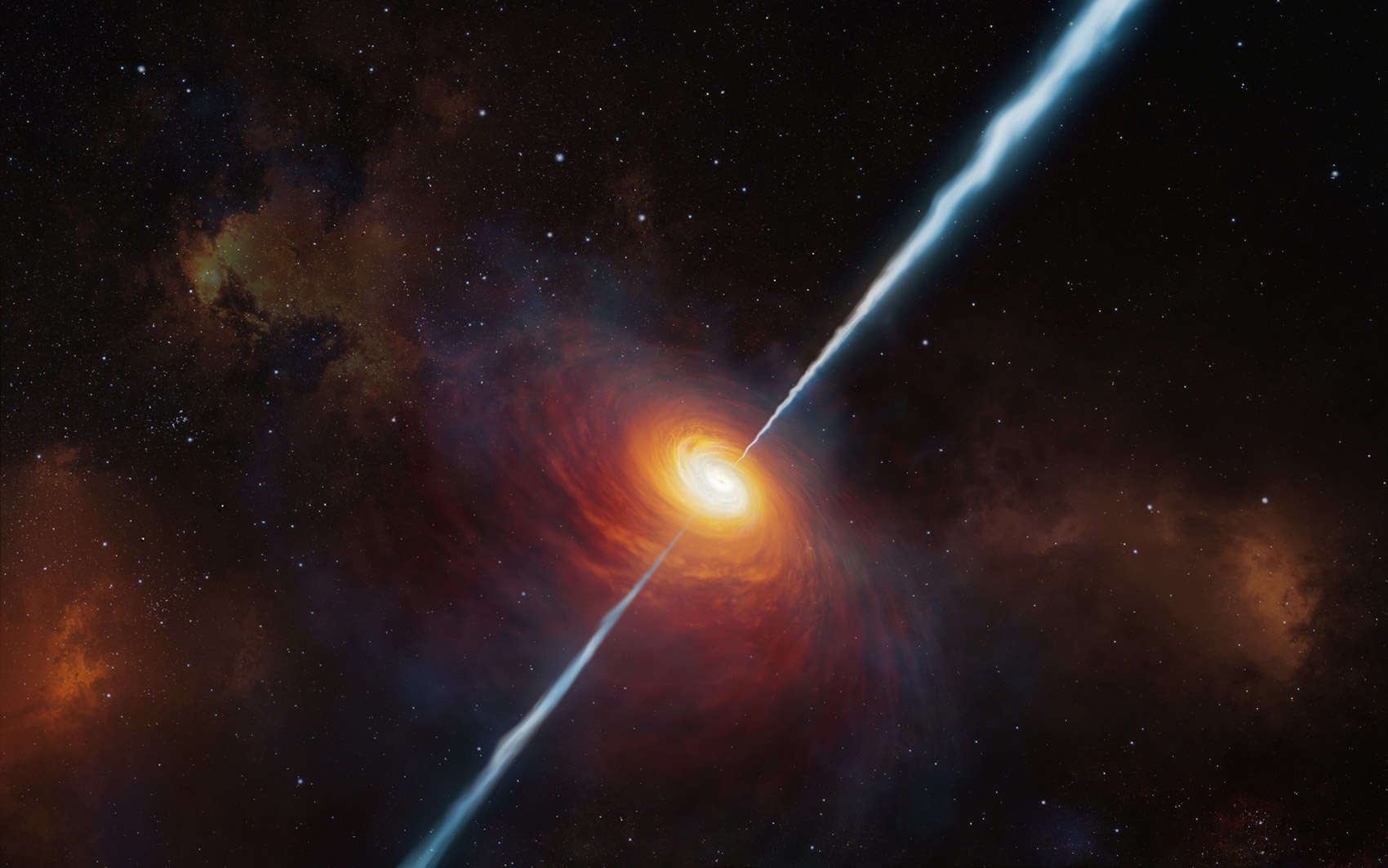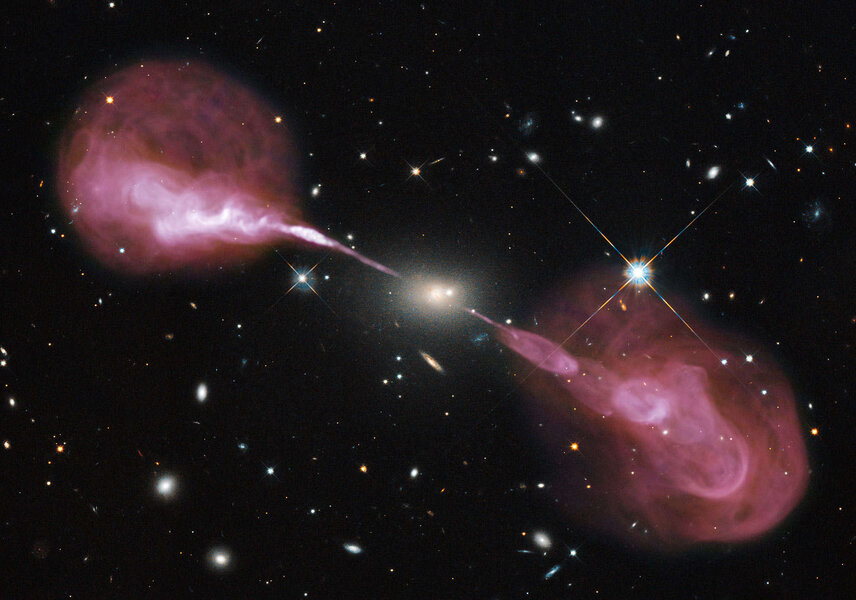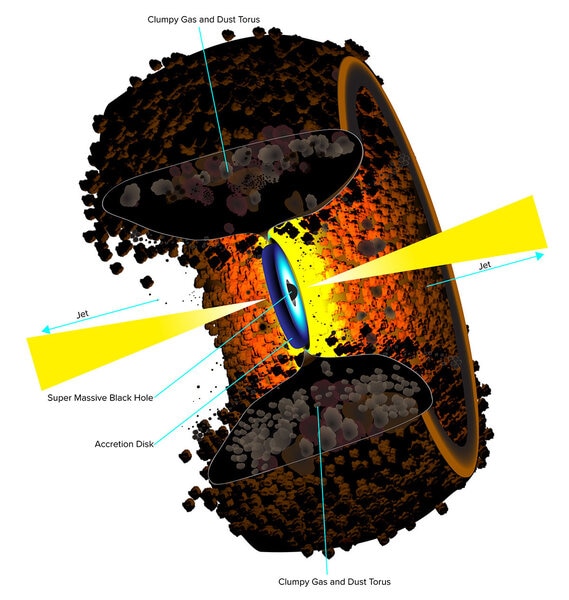Create a free profile to get unlimited access to exclusive videos, sweepstakes, and more!
A quasar at the edge of the observable Universe has its radio turned *way* up

Astronomers have discovered a powerful quasar very near the edge of the observable Universe, a staggering 13 billion light years from Earth. While many quasars at this distance are known, this one is special: It's "radio loud," meaning it's pouring out radio energy, making it part of a special class that can help us better understand conditions when the Universe was very young.
Quasars are themselves a special kind of galaxy. As far as we know, every big galaxy has a supermassive black hole in its core. Most galaxies today have black holes that are quiet, that is, not actively feeding on material. The Milky Way falls into that class.
Some, though, do have material falling into their central supermassive black hole, and we call these active galaxies. Material falling into the black hole forms an incredibly hot disk around it called an accretion disk, and outside of that can be a huge donut-shaped dust cloud.
On top of all that, the accretion disk has extremely strong magnetic fields embedded in it. As the stuff swirls around the black hole these fields get wound up like tornadoes, and material gets blasted away from the black hole at very near the speed of light. We call these structures jets, and they are features of immense power.
What we see from an active galaxy depends in large part on our viewing geometry. If the jet is aimed at us we can see high-energy light like X-rays and gamma rays. If we see the dust torus edge-on it can block most of the high-energy stuff and we only see optical or infrared light. There's a whole menagerie of active galaxy types out there.
Quasars tend to have a lot of high-energy light (the first was discovered by its X-ray emission) and early on were also seen to be powerful sources of radio energy. But as we learned more we found that radio-loud quasars* (as ones with lots of radio emission are called) are actually in the minority; only 10% of all quasars are radio loud.
The newly discovered quasar is called PSO J172.3556+18.7734 (let's call it P172 for short). It was found in a sky survey using optical light (the kind we see), and had colors that indicated it was at great distance. A follow-up observation confirmed it, and a series of observations using huge 'scopes like Keck and the Large Binocular Telescope confirmed its great distance: About 13 billion light years (or, more accurately, it took 13 billion years for the light to reach us).
More observations using the Very Large Array radio telescope also showed that unlike most quasars, it was blasting out radio energy. There are about 200 quasars known farther away than roughly 12.7 billion light years, and only 3 are known to be radio loud. At 13 billion, only 18 quasars are known, and P172 is the only one that's radio loud.
Looking at spectra of the target, astronomers determined P172's central black hole has a mass of about 300 million times that of the Sun, making this a medium-to-hefty one (the one in the center of the Milky Way is only 4 million solar masses, though admittedly ours is smaller than most).
This part is interesting: As matter falls in it gets incredibly hot and tremendously bright. By measuring just how bright, astronomers can determine how rapidly the black hole is feeding. Usually there's an upper limit to the rate at which it feeds; the matter gets so hot that the sheer force of the light it emits blows away material falling in from farther out. This rate is called the Eddington limit; in general it's the fastest rate at which a black hole can gorge.
But the black hole in the center of P172 is feeding at a rate much higher than the Eddington limit. It turns out that's possible if it's blasting out jets as well; the physics isn't well understood but active galaxies with jets, especially radio-loud ones, seem to be able to funnel material much more rapidly into the black hole. So the fact this quasar is so bright is telling us about the conditions around its black hole.
Also, very distant radio-loud quasars tend to be located in regions of the Universe with more material than usual. It's thought that these enormous clouds collapse to form not just galaxies but clusters of galaxies, so finding a radio-loud quasar this far out may also lead to a better understanding of how these clusters form.
Not only that, but when compared to other quasars like it, P172 is about average in radio loudness. We know some are much more powerful, and that means that it's likely we can find more galaxies like it that are even farther away! P172 may hold the current distance record for radio-loud quasars, but it's unlikely to hold that distinction for long. And the more we find the more we understand the Universe when it was less than 800 million years old.
I usually don't like to write about broken records because they usually just get broken again. But this one is different, since a) it's helpful any time an object like this is found at great distance, and 2) the fact that it exists at this distance at all indicates there may be many more like it.
Finding objects at these huge distances is terribly difficult work because they're extremely faint and there aren't too many of them in the sky. The good news is this one is telling us to keep looking. There're more fun things out there to be found.
*This term is a funny one. Radio waves are a form of light, not sound, and it's common for people to confuse the two because we can convert radio waves to sound and transmit information on them, like music or obnoxious bloviating political know-nothings. Worse, we call the device we listen to a radio, so this is a complete mess. Astronomers aren't helping by talking about radio-loud objects. We should call them radio bright, though heaven knows if that would cause less confusion.
















